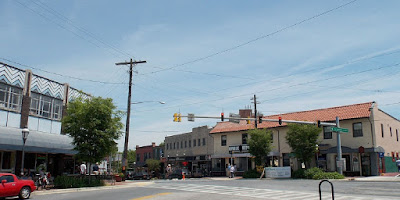Cowboys
Cowgirls Music and Culinary Traditions
The American South is comprised of 14 States from Oklahoma
and Texas to the Gulf Coast and South Atlantic port cities and from the Ohio
and Mississippi Rivers to New Orleans.
Historical Tourism and
Victorian Architecture
Guthrie lies along one of the primary corridors into Texas
and Mexico and is a four-hour drive from the Dallas-Fort Worth metropolitan
area. The city is in the center of the state, about 32 miles - 51 km -
north of Oklahoma City, in the Sandstone Hills region of Oklahoma, known for
hills and oak forests
Dallas is relatively young city with a colorful past. In
1839, John Neely Bryan, a lawyer from Tennessee with a taste for adventure,
wandered into the area and was impressed with what he believed to be the
perfect ingredients for a trading post and eventually a town: plenty of raw
land, Indians with whom to do business, and the river. The young city’s can-do
spirit helped bring railroads in the 1870s, the Federal Reserve Bank in
1914, Southern Methodist University in 1915, Love Field Airport in 1927, the
Texas Centennial Exposition in 1936 and DFW International Airport in 1973.

Fort Worth was settled in 1849 as an army outpost along the
Trinity River as one of eight forts assigned to protect settlers on the
advancing frontier. The cattle industry was king for a generation of people
working the Fort Worth leg of the historic Chisholm Trail, which ran from the
1860s to the 1870s when the Texas & Pacific Railway arrived. In the years
that followed, oil and aviation brought new wealth throughout the region. The
post-war years found Fort Worth capitalizing on its strengths as a transport,
business and military center. Cultural pursuits included the development of the
city's internationally acclaimed museum district.
Texas Cities and the Hill Country Austin, on the eastern edge of Texas Hill Country, is the state
capital, the live music capital of the world, a center for film, home to the
University of Texas and Formula 1's Circuit of the Americas raceway. The city’
parks and lakes are popular for hiking, biking, swimming, boating and other
outdoor pursuits as well as a ballet, museums and unique shopping experiences.
San Antonio’s rich heritage includes 18th century
Spanish colonial missions, residential areas dating from the 1860s and local
museums that celebrate the city’s past. The San Antonio Mission Trail begins at
the Alamo and winds southward along a nine-mile stretch of the San Antonio
River.
New Orleans was established by the French in 1718 at a
location that continues to be a valuable site for trade due to its strategic
position along the Mississippi River. The French Quarter is a National Historic
Landmark and is bordered by Canal, Decatur and Rampart Streets and Esplanade
Avenue. It boasts cultural contributions from the French, Spanish, Italians,
Africans and Irish.
Reduce
Transit Times and Travel Costs on Your Next Trip
Mobile Alabama is located at the head of Mobile Bay and the
Central Gulf Coast. Founded by the French in 1702, during its first 100 years,
Mobile was a colony of France, Britain and Spain; it became a part of the
United States of America in 1813.
Savannah was founded in 1733 on the Savannah River, it
became the colonial capital and later the first state capital of Georgia. Its
port was of strategic importance during both the American Revolution and the
Civil War.
Charleston was founded in 1670, Charleston is defined by
its cobblestone streets, horse-drawn carriages and pastel pre-Civil-War-era
houses, particularly in the bustling French Quarter and Battery areas. The
Battery promenade and Waterfront Park both overlook Charleston Harbor, while
Fort Sumter, a Federal stronghold where the first shots of the Civil War rang
out, lies across the water.
Charlotte is named in honor of King George III of Britain’s
consort. It is a city with 199
neighborhoods and many nicknames, including: the famed Hornet’s Nest derived
from the American Revolution, The QC, Crown Town, Home of NASCAR, Gem of the South, CLT, Bank Town,
Char-Town and City of Trees.
Asheville has a fascinating past; experience a walking
itinerary that commemorates the city’s most significant cultural, educational,
social and architecture stories; a museum without walls. Urban Farm and
Mountain Trails Gourmet Cuisine Public Art Music Heritage and a Bohemian
Culture.
Louisville is centrally located along the Ohio River and is
one America’s most accessible cities within a day’s drive of more than half the
nation’s population. This city has a colorful past, from its frontier
founding at the time of the American Revolution, to early 19thcentury
steamboats and as a Union base during the Civil War. Named for King Louis XVI
of France in appreciation for his assistance during the Revolutionary War,
Louisville was founded by George Rogers Clark in 1778.
Nashville has been the subject of many books, movies and
songs. But, while music is the lifeblood of this city, you will also find here
culture, history, haute cuisine, sports, natural beauty and especially Southern
charm.
Memphis is a city with a rich and eclectic history. Some of
the city’s traditions and milestones: the home of Elvis Presley, the Memphis
Zoo, the Indie Memphis Film Festival, Sun Studio, National Civil Rights Museum,
Stax Museum of American Soul Music and the Beale Street Music Festival.
The Sights Sounds and Culinary
Traditions of the Mississippi
Regions. A melting pot of cultures, a mighty river, antebellum mansions and
restaurants featuring soul food, authentic ethnic dishes and modern culinary
delights. The tastes of this region take their influences from Native American heritage.
a
true melting pot of regional, ethnic, national and international cuisine




















